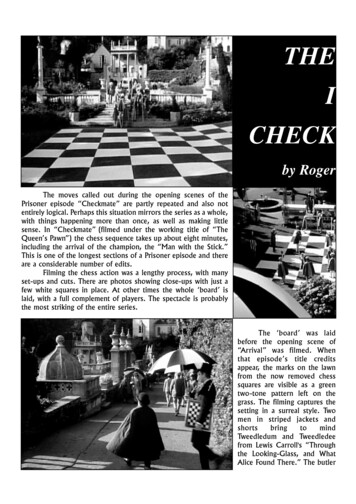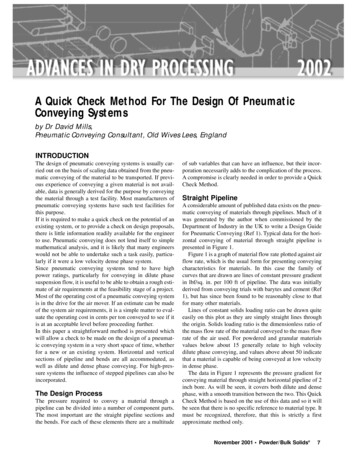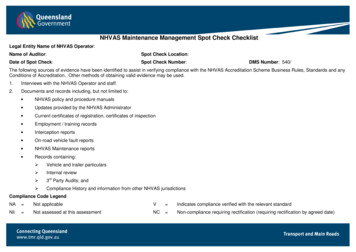
Transcription
THEICHECKby RogerThe moves called out during the opening scenes of thePrisoner episode “Checkmate” are partly repeated and also notentirely logical. Perhaps this situation mirrors the series as a whole,with things happening more than once, as well as making littlesense. In “Checkmate” (filmed under the working title of “TheQueen’s Pawn”) the chess sequence takes up about eight minutes,including the arrival of the champion, the “Man with the Stick.”This is one of the longest sections of a Prisoner episode and thereare a considerable number of edits.Filming the chess action was a lengthy process, with manyset-ups and cuts. There are photos showing close-ups with just afew white squares in place. At other times the whole ‘board’ islaid, with a full complement of players. The spectacle is probablythe most striking of the entire series.The ‘board’ was laidbefore the opening scene of“Arrival” was filmed. Whenthat episode’s title creditsappear, the marks on the lawnfrom the now removed chesssquares are visible as a greentwo-tone pattern left on thegrass. The filming captures thesetting in a surreal style. Twomen in striped jackets andshortsbringtomindTweedledum and Tweedledeefrom Lewis Carroll's “Throughthe Looking-Glass, and WhatAlice Found There.” The butler
MOVESNMATELangleyoversees proceedings from the top of the bandstand (Portmeirion’sBristol Colonnade). It is not clear whether he is following themoves, or controlling them. Atop two tall ladder trestles sit thechess champion and his opponent. Thus we have the commencement of “Checkmate,” an opening unlike any other in the series.The game is able to proceed without interference from theControl Room supervisor, No. 56, or even No. 2, who visits the‘bridge’ to check on events taking place outside on the lawn. Thefacial expressions of No. 6 indicate that he regards the whole display as a sham, a charade being performed for his benefit, or perhaps for the amusement of the Villagers. Whatever might be thepurpose of the game, it is over far more quickly than a traditionalmatch and the ending serves mainly to introduce No. 6 to thechampion (and briefly to the ‘White Queen’).Writer Gerald Kelseymay have had in mind that thestory would reflect chessmoves, throughout the lateraction. However, this does nothappen and the early chessmatch is all but forgotten. No.6 marks his newspaper on thechess page, but no other references to the game appear.Therefore this reviewlooks at the chess sequenceitself, a spectacle revisitedmany times by Six of One, during Prisoner conventions inPortmeirion, across the years.
The moves during thegame stack up as follows:Champion:fourPawn to King'sOpponent:fourPawn to King'sChampion: Knight toQueen's Bishop threeOpponent: Knight toKnight's Bishop threeOpponent:Bishop to Knight fourChampion:Knight to King's Bishop threeOpponent:Bishop to Bishop fourChampion:Knight to Knight fiveOpponent:Knight to Knight's Bishop threeChampion:Pawn to Queen's four!!!!Opponent:Bishop to Queen's threeChampion:fiveKnight to KnightChampion:threeQueen to King'sOpponent:fourBishop to BishopChampion: Knight toQueen's Bishop threeOpponent:threeKnight to Queen(Various other moves all saidtogether)Opponent:Castle
Rook:Check!Opponent:Bishop's fiveRook toChampion:Bishop's fourBishop toOpponent:Knight's fourBishop toChampion:Queen toKing's three - Checkmate!Thereissomeungentlemanly prodding ofNo. 6 with chess poles, ashe doesn’t move when called upon to do so and there is theremoval of the recalcitrant Rook, after he moves withoutauthority. Thus the game itself and some of the goings-onwithin it, make for a ver y un-chess-like performance.The many colourful capes, poles, squares, costumesand straw boaters must have made this scene expensive tostage. The event and Portmeirion’s lower lawn were almost‘made for each other’ and - apart from convention weekends - the grassy area seems empty without its squares and‘citizens.’ However, “Checkmate” is not the only episodein which chess features. In the opening two stories - usingthe ‘standard’ running order - the game makes an appearance.In “Arrival”, the exAdmiral is said, by No. 2,to be an “excellent chessplayer”. The senior citizenlater checkmates No. 6 atthe end of the episode.Subsequently he offers thewoman No. 9 a game,telling her “ We’re allpawns, my dear.” In the followingepisode“TheChimes of Big Ben”, thegeneral is playing chess withNo. 6 and says that hethinks he will make a set forthe coming Arts and Crafts
Exhibition. No. 6 describesto No. 2 his skill in producing “mate in seven moves”.The Village leader asks howmany the prisoner knows.“A few more,” comes thereply. “We must play sometime,”saysNo.2.“Certainly we must, bypost,” responds No. 6.Later,attheExhibition, No. 6 asks thegeneral if it is his chess setwhich the prisoner isinspecting, telling him “It’sver y good.” The generalparticularly likes the King,which he has made in the likeness of No. 2.In Arrival, we see that No. 6 has a chess set on theshelf in his Village apartment, although we do not see himplaying (and this would require him to have a visitor, toprovide him with an opponent).Apart from the occurrences described so far, chessseems to disappear from the Prisoner series during theother episodes. The chess squares are no longer seen onthe lawn and the poles with their emblems are not seen,although capes remain a common item of daywear amongstthe citizens. The game of chess would probably not appealto the Village authorities as it is, by its ver y nature, builtupon random choices, preventing the game being con-trolled by one side, or bysome overseeing authority.This tends to suggest thatthe game we see in“Checkmate” has no greaterpurpose than say the election parades in “Free ForAll” or the carnival processions in “Dance of theDead”.During the rest of theplot of “Checkmate”, theaction veers away fromchess completely. No. 2 isconcerned with brainwashing - with the help of his
psychiatrist - the ‘Rook’and the ‘ White Queen’,while No. 6 is rounding upa band of conspirators inorder to plot an escape. Thetwo sides come together atthe end, with No. 6’s planfailing because of ‘one falsemove’, on the part of the‘Rook’. Clearly the ‘piece’has been playing on bothsides and has thereforecaused No. 6’s game strategy to collapse. At the endof “Checkmate”, we see apawn being placed on theButler’s chessboard, indi-cating that No. 6 is once more under the full control of theVillage. Interestingly, there is little reference to the ‘King’in this stor y, he being set apart from the other pieces, inthe same way that No. 1 is not part of the general community. In the end, unlike the case with chess, nothing in theVillage is black or white, with events being unpredictablefor a Prisoner like No. 6. Until he - like others before him- accepts confinement and complies with the Village’srequirements, they will be subjected to all manner ofunpleasant experiences and types of coercion. Others knowtheir place - as with pieces on a chessboard - but No. 6,like the ‘Rook’ will always rebel and refuse to ‘play thegame’.No. 6 also plays a wordgame with the LoveGame?TableShipRedFreeDogShyWorkAnchorThe Hope andAnchor. It's apub I used todrink at.LeafAwayGameGameTennisChairShapeSailFor All
‘citizens.’ However, “Checkmate” is not the only episode in which chess features. In the opening two stories - using the ‘standard’ running order - the game makes an appear-ance. In “Arrival”, the ex-Admiral is said, by No. 2, to be an “excellent chess player”. The senior citizen later checkmatesNo. 6 at the end of the episode.











